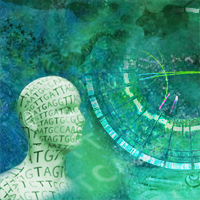 Functions and mechanisms of gene regulation
Functions and mechanisms of gene regulation
We have developed several technologies to characterise and quantify transcriptome architecture as well as its functional impact. In particular, we are interested in the function and regulation of non-coding RNAs, antisense transcription, transcriptional heterogeneity, and the molecular phenotypes that arise from pervasive transcription. Recently, we discovered that translation and degradation occur in parallel on the same mRNA allowing ribosome movement to be captured.
 Quantitative genetics
Quantitative genetics
We have piloted new technologies to dissect the genetic and environmental interactions that underlie complex, multifactorial phenotypes. We are interested in studying the consequences of genetic variation, learning to predict phenotype from genotype, and integrating multiple layers of molecular data to define intervention points that can be targeted to modulate phenotypes of interest.

Disease models
We apply personalised functional genomics to study diseases in patient-derived cells using systematic and targeted approaches to unravel mechanisms and discover novel treatments. We also develop point-of-care biosensors that monitor an individual’s health and facilitate early disease diagnosis and intervention, even before symptoms set in. We apply these approaches to NGLY1 deficiency (see video), cancer, chronic fatigue syndrome (OMF), and dilated cardiomyopathy (DCM).
Familial DCM is a genetic heart disease with reduced contractility of the heart muscle, leading to heart failure. We seek to understand, monitor and treat DCM at a molecular level, based on genetic predisposing factors. To achieve this, we are using both cellular (engineered and patient-derived iPSCs) and mammalian models. We have setup a fund to support this research. Click here for information on donating to the Steinmetz Cardiomyopathy Fund.
Pictures 1-2: Copyright EMBL, Credits Petra Riedinger, 1. EMBL Conference Transcription and Chromatin, 2. EMBL Conference Cancer Genomics, Picture 3: https://en.wikipedia.org/wiki/Cardiomyopathy#/media/File:Tipet_e_kardiomiopative.png
